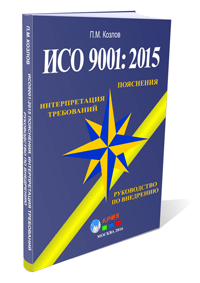The International Organization for Standardization has developed two standards on the 6 Sigma concept:
ISO 13053-1:2011 «Quantitative methods in process improvement. Six Sigma Part 1: DMAIC methodology». This standard unifies the
application of the 6 sigma concept and provides recommendations on the application of the DMAIC methodology during the implementation
of six sigma projects. Also, this standard defines the procedure for managing 6 sigma projects, sets requirements for project participants,
their roles and training requirements.
The standard applies only to projects for improve existing processes. This standard is not suitable for designing new processes (or redesigning), because the DMADV methodology (DFSS) has been developed in the 6 sigma concept for these purposes. The ISO 13053-1:2011
standard can be applied to organizations of any scope.
ISO 13053-2:2011 «Quantitative methods in process improvement. Six Sigma Part 2: Tools and techniques» - This standard represents
the composition of 6 sigma tools and methods used at each stage of the DMAIC methodology. Also, the standard provides a summary of
methods and tools.
ISO 13053-1:2011 standard structure
Foreword
Introduction
1 Scope
2 Normative references
3 Symbols and abbreviated terms
3.1 Symbols
3.2 Abbreviated terms
4 Fundamentals of Six Sigma projects within organizations
4.1 General
4.2 Voice of the customer
4.3 Accountability
4.4 Maturity of processes of an organization
4.5 Relationship with quality management standard ISO 9001
5 Six Sigma measures
5.1 Purpose
5.2 Defects per million opportunities (DPMO)
5.3 Sigma score
5.4 Rolled throughput yield (RTY)
5.5 Return rate (RR)
5.6 Number of problem reports (NPR)
5.7 On-time delivery (OTD)
5.8 Cost of poor quality (COPQ)
6 Six Sigma personnel and their roles
6.1 General
6.2 Champion
6.3 Deployment Manager
6.4 Project Sponsor
6.5 Master Black Belt
6.6 Black Belt
6.7 Green Belt
6.8 Yellow Belt
7 Minimum competencies required
8 Minimum Six Sigma training requirements
8.1 Recommended training
8.2 Training requirements for Champions / Deployment Manager
8.3 Training requirements for Sponsors
8.4 Training requirements for Master Black Belts
8.5 Training requirements for Black Belts
8.6 Training requirements for Green Belts
8.7 Training requirements for Yellow Belts
9 Six Sigma project prioritization and selection
9.1 General considerations
9.2 Project prioritization
9.3 Project selection
10 Six Sigma project DMAIC methodology
10.1 Introduction
10.2 Define phase
10.3 Measure phase
10.4 Analyse phase
10.5 Improve phase
10.6 Control phase
11 Six Sigma project methodology — Typical tools employed
12 Monitoring a Six Sigma project
12.1 General
12.2 Gate reviews
12.3 Project management
12.4 Weekly mentoring sessions with a Master Black Belt
13 Critical to success factors for Six Sigma projects
14 Six Sigma infrastructures within an organization
14.1 General information
14.2 Large - Over 1 000 employees at a site
14.3 Medium – 250 to 1 000 employees at a site
14.4 Small – Less than 250 employees at a site
14.5 Multiple sites
Annex A Sigma scores
Annex B Training
B.1 Typical Black Belt training agenda
B.2 Typical Green Belt training agenda
Bibliography
ISO 13053-2:2011 standard structure
Foreword
Introduction
1 Scope
2 Terms and definitions
3 Symbols and abbreviated terms
3.1 Symbols
3.2 Abbreviated terms
4 DMAIC process sequence
4.1 Define phase
4.1.1 Objectives
4.1.2 Steps
4.2 Measure phase
4.2.1 Objectives
4.2.2 Steps
4.3 Analyse phase
4.3.1 Objectives
4.3.2 Steps
4.4 Improve phase
4.4.1 Objectives
4.4.2 Steps
4.5 Control phase
4.5.1 Objectives
4.5.2 Steps
Annex A Factsheets
Factsheet 01 — ROI, costs and accountability
Factsheet 02 — Affinity diagram
Factsheet 03 — Kano model
Factsheet 04 — CTQ tree diagram
Factsheet 05 — House of quality
Factsheet 06 — Benchmarking
Factsheet 07 — Project charter
Factsheet 08 — Gantt chart
Factsheet 09 — SIPOC
Factsheet 10 — Process mapping and process data
Factsheet 11 — Prioritization matrix
Factsheet 12 — Cause and effect diagram
Factsheet 13 — Brainstorming
Factsheet 14 — Failure mode and effects analysis (FMEA)
Factsheet 15 — Measurement system analysis (MSA)
Factsheet 16 — Data collection plan
Factsheet 17 — Determination of sample size
Factsheet 18 — Normality testing
Factsheet 19 — Descriptive statistics visualization tools
Factsheet 20 — Indicators
Factsheet 21 — Waste analysis
Factsheet 22 — Value stream analysis (VSM)
Factsheet 23 — Services delivery modelling
Factsheet 24 — Hypothesis testing
Factsheet 25 — Regression and correlation
Factsheet 26 — Design of experiments (DOE)
Factsheet 27 — Reliability
Factsheet 28 — RACI competencies matrix
Factsheet 29 — Monitoring / control plan
Factsheet 30 — Control charts
Factsheet 31 — Project review
Bibliography
